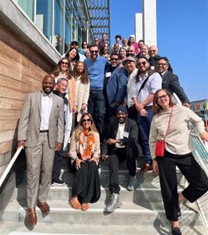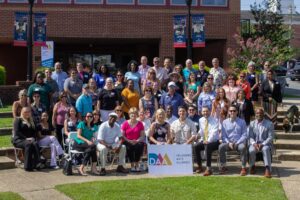June
2024
June 7, 2024
California, Delaware, Illinois, Massachusetts, Washington: Planning for the Creative Economy
As state governments seek to leverage the economic power of the arts, multiple state arts agencies (SAAs) have been selected to assist in leading strategic plans for their states’ creative economies. State policymakers are seeking to capitalize on the outsize role the creative economy plays in both economic value added and jobs created, with arts and culture contributing 4.3% of the U.S. national economy and accounting for over 5.18 million jobs. Additional new research from Indiana University reinforces the importance of a strong creative economy, with the report pointing to the vital role that arts and culture play in supporting economic resiliency and growth during economic downturns.
Each of the creative economic development strategies outlined below highlights the ways in which states are considering the competitive advantage of the arts and culture locally, nationally and globally. With plans underway in California, Delaware and Washington, SAAs are helping to guide the state’s creative sector and ensuring its benefits reach all constituents. Additional legislation in Illinois and Massachusetts shows the drive with which state legislatures and administrations are acknowledging the creative economy as a vital component of economic development and state arts agencies as invaluable partners for this work.
California

The first public meeting of the Creative Economy Workgroup convened in May 2024 in Santa Monica, California. Photo courtesy of California Arts Council
Pursuant to Assembly Bill 127, which was enacted in September 2023, the California Arts Council (CAC) is charged with establishing and chairing the California Creative Economy Workgroup. Supported by a legislative appropriation of $1 million, the workgroup is mandated to draw upon cross-sector expertise, including representation from county and city associations, multiple arts disciplines, higher education institutions, state economic development and workforce agencies, a federally recognized Indian tribe, and other relevant parties.
The workgroup is responsible for developing a strategic plan for California’s creative economy. The plan must seek to improve the competitiveness of California’s creative economy, with a focus on attracting business, retaining talent and developing content for national and international export. Additional responsibilities include:
- collecting and analyzing data on California’s creative economy
- evaluating private financing models and existing tax incentives
- developing incremental phases for the plan’s rollout
- creating specific strategies to reach historically marginalized communities and incorporating diverse perspectives
The initiative has just begun, with members of the workgroup selected in December 2023 and a project manager hired in early 2024. The group is convening public meetings and has launched a Creative Futures newsletter. The plan is due to the state legislature by June 2025. To find out more, contact California Arts Council Director of Public Affairs Carissa Gutierrez.
Delaware

State, county, and local elected officials, along with leaders in and patrons of the creative economy, united to kick off the community engagement phase of Delaware’s Creative Economy project. Photo courtesy of Jordyn Gum
Since 2023, the Delaware Arts Alliance (DAA) has been driving a groundbreaking research process to propel Delaware’s creative economy and cultural tourism sector forward. The Creative Economy Advancement and Tourism Expansion (CREATE) plan, an initiative led by DAA, engages Delawareans in shaping a shared vision for a thriving, inclusive and interconnected creative economy. This project—the first of its kind in the nation—delves into the full creative landscape at the state, county and city levels. Developed with input from over 600 Delawareans from all walks of life, the CREATE plan tackles postpandemic challenges and provides actionable solutions to strengthen Delaware’s creative economy.
The CREATE plan consists of three major areas of focus:
- Economic impact: The economic impact analysis provides a reliable measure of the importance of the creative economy in Delaware on three dimensions: direct, indirect and induced impacts. Additionally, the research contains an examination of earnings data and an analysis of sector changes within the creative economy since before the pandemic.
- Online asset map: Using this searchable index of 2,534 creative economy assets in Delaware, users can explore and find creative professionals statewide by sector, subsector, county and city.
- Recommendations: The CREATE plan provides a clear, actionable roadmap of 25 recommendations for strengthening the state’s arts and tourism sectors. The plan outlines policy changes and investments that can support the creative economy’s postpandemic recovery and continued prosperity.
For more information, contact Delaware Arts Alliance Executive Director Neil Kirschling.
Illinois

Annual Glenwood Ave Arts Festival. Photo courtesy of Illinois Arts Council
The Illinois legislature is currently considering bill H.B. 4959, which would develop a Creative Economy Task Force within the Department of Commerce and Economic Opportunity. The executive director of the Illinois Arts Council would serve as vice chair of the task force and would sit alongside the governor and legislature appointees from the arts community as well as representatives from different sectors and association groups.
The new task force would be charged with both determining the current state of the creative economy in Illinois and developing a strategic plan with incremental phases of rollout. The plan would be developed with an eye toward attracting new creative businesses, retaining existing talent, and increasing national and international export of marketable content. Additional consideration would be given to the creative community within historically marginalized communities and geographic areas with the least amount of access to the creative economy.
The scope of the task force also would include a comparative analysis of other jurisdictions, interviews with constituents and an evaluation of current financial models and creative education assets. If this legislation is enacted, the strategic plan would be due to the general assembly no later than July 2026. For more information on the creative economy within Illinois, contact Illinois Arts Agency Executive Director Joshua Davis-Ruperto.
Massachusetts
As outlined in Mass Cultural Council’s FY24-26 Strategic Plan, one of the agency’s top priorities is advancing the creative economy and cultural sector in Massachusetts. The agency will do this through fostering partnerships, advocating for impactful cultural policies, analyzing economic data, and increasing community and partner advocacy around the creative economy.

Face painting takes place during Berkshire Busk, a downtown festival in the Great Barrington cultural district. Photo courtesy of Mass Cultural Council
This priority is borne out in the governor’s economic development bond bill, which includes a $50 million capital spending authorization for cultural facility improvements and $40 million for destination development grants with a priority for projects in cultural districts and rural tourism. A live-theater tax credit pilot program also would be implemented as part of the legislation, subject to a $5 million annual cap. If enacted, this spending would take place as part of a statewide plan to invest $3.5 billion in economic development over the next four years.
The governor is also backing creative economic development through executive action that established a Cultural Policy Development Advisory Council within the Office of the Governor. The executive director of Mass Cultural Council sits on this council alongside the executive director of the Office of Travel and Tourism, the secretary of Economic Development, and 15 governor-appointed members who represent the diversity of the state’s arts and culture sector. The administration has prioritized cultural districts as sites of economic growth, with additional consideration being given to infrastructure, planning and other community development grants within cultural district borders.
Key policy objectives and other action to support arts and cultural economic activity are outlined in the administration’s Mass Leads: Tourism, Arts and Culture policy brief and the Mass Cultural Council article Key Policy Wins. For more on the creative economy in Massachusetts, contact Mass Cultural Council Senior Director of Public Affairs Bethann Steiner.
Washington
Recognizing the value of the creative economy to the state, the 2022 Washington legislature appropriated $683,300 to the Department of Commerce to contract with a nonprofit organization to develop a Washington state Creative Economy Work Group. The work group was instructed to develop a strategic plan with distinct phases that addressed Washington’s creative competitiveness and supported creative communities within historically marginalized communities. Assisted by the Western States Arts Federation, the work group included representatives from ArtsWA (Washington State Arts Commission) and members of the multidisciplinary state arts community, the state labor council, two federally recognized tribes, county and city associations, and other members at the discretion of the work group.
 The final strategic plan, Creative Washington, was launched in December 2023. The plan identifies four priority areas for a robust creative economy: equity and access, infrastructure and investment, learning and skills, and sector and workforce development. Each priority area is defined by a goal and two strategies for its achievement. The plan is designed to be implemented over five years and each strategy section breakout suggests initial steps, prospective partners and proposed investments (which total nearly $20 million). Additional case studies highlight current enterprises and creative endeavors that could serve as models for the proposed work.
The final strategic plan, Creative Washington, was launched in December 2023. The plan identifies four priority areas for a robust creative economy: equity and access, infrastructure and investment, learning and skills, and sector and workforce development. Each priority area is defined by a goal and two strategies for its achievement. The plan is designed to be implemented over five years and each strategy section breakout suggests initial steps, prospective partners and proposed investments (which total nearly $20 million). Additional case studies highlight current enterprises and creative endeavors that could serve as models for the proposed work.
The strategic plan draws on input from over 400 individuals through interviews, discussion groups and a statewide survey that reached across the nine state regions. Initial quantitative research provided an analysis of the current strength of the creative economy and an ecosystem model. To learn more, contact ArtsWA Executive Director and Creative Economy Work Group Member Karen Hanan.
NASAA has previously featured the work of the Vermont Arts Council, which developed the CreateVT Action Plan in 2021. A 2022 progress report includes steps taken to achieve each of nine goals as well as plans for further action.
Additional creative economy resources are available from NASAA, including state breakdowns of creative economic activity and competitiveness, a database of economic studies, key facts and figures, and additional resources on resiliency, rural prosperity, and economic and community development. For more information, contact NASAA Senior Director of Research Ryan Stubbs.
In this Issue
From the President and CEO
State to State
- California, Delaware, Illinois, Massachusetts, Washington: Planning for the Creative Economy
- Michigan: New Grant-making Initiatives
Legislative Update
The Research Digest
Announcements and Resources
More Notes from NASAA
SubscribeSubscribe
×
To receive information regarding updates to our newslettter. Please fill out the form below.
